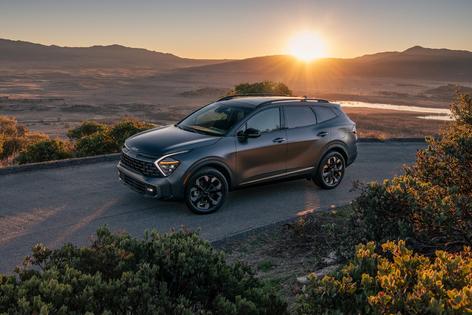Eric's Autos: 2025 Kia Sportage Plug-in Hybrid
Plug-in hybrids like the Kia Sportage are ingenious things. Not so much because they can be driven entirely on battery power until they run low on charge -- just like a vehicle powered entirely by a battery -- but because you don't have to stop when the plug-in hybrid runs low on charge. You don't even have to plug it in, if you prefer not to.
In brief, it cuts the cord that tethers the owner of a vehicle powered entirely by electricity -- while providing some of the benefits of owning an electric vehicle, such as paying less, and maybe even next to nothing, for gas.
With a small catch.
What It Is
The Sportage is a compact, two-row crossover one size down from Kia's slightly larger (and three-row) crossover, the Sorento.
It differs from the regular Sportage in two main ways. The first, of course, being that it has a plug-in hybrid drivetrain -- which means it can be recharged without driving it. But also, you can just drive it, and for about 35 miles on battery power alone, if you start your drive with a fully charged battery.
The other difference is what it costs versus the non-hybrid Sportage -- which lists for $27,190 to start for the base LX trim. The plug-in Sportage starts at $39,690 for the X-Line trim and tops out at $44,190 for the X-Line Prestige trim.
Part of the price difference has to do with the plug-in's more elaborate (and so, more expensive) drivetrain, which includes an engine and an electric motor plus a rechargeable battery pack (like an EV has) to store electricity to power the motor as well as some of the vehicle's accessories -- such as the AC and power steering -- when the engine isn't running. But the plug-in also starts out with more standard equipment, including synthetic leather seats with heaters, a panorama sunroof, a wireless charging pad and 12.3-inch combination main gauge cluster/secondary system interface.
What's New For 2025
The Sportage plug-in (which made its debut in 2023) carries over into 2025 unchanged.
What's Good
-- Does not have to be plugged in, but can be plugged in.
-- About 35 miles of range on the batteries -- and about 400 miles of range regardless.
-- Can tow almost as much as the non-hybrid Sportage.
What's Not So Good
-- Not burning gas costs a lot of money.
-- Highway gas mileage (35 mpg) is essentially the same as the much less expensive non-hybrid Sportage's (33 mpg).
-- Voice command interface for the audio system is technologically interesting, but what happens when it glitches?
Under the Hood
The Sportage plug-in hybrid has one of the smallest, strongest and most fuel-efficient engines ever put in a 2-ton-plus (4,229-pound) vehicle. Just 1.6 liters -- exactly the same-size engine (and the same number of cylinders) that powered Volkswagen Beetles (the original, rear-engined ones) back in the '70s. But the Beetle of the '70s weighed half as much -- and its 1.6-liter four-cylinder engine didn't produce 261 horsepower, which the Kia's does.
Both do get about the same gas mileage, though.
The hybrid Kia rates 36 mpg city, 35 mpg highway -- about what you'd get out of a '70s Beetle if the engine was running right. And the Beetle needed to burn a gallon of gas to take you plus-or-minus 35 miles down the road.
The Kia doesn't.
Not if its battery pack is fully charged up, which you can do by plugging it in to a 240V (household electric dryer-type) outlet. After about three hours, it's ready to go -- without burning any gas at all.
But the really ingenious thing is you don't have to stop when it runs out of charge because there's that 1.6-liter gas engine to keep you going (and charging the battery while you drive). The even more ingenious thing is you never have to plug it in -- if you prefer not to. If you don't, it will operate like a regular hybrid that alternates between engine on and engine off, with the engine cutting off when the vehicle isn't moving or coasting/decelerating -- but coming back on as needed to keep the vehicle moving.
On the Road
Driving an entirely electrically driven vehicle is different from driving a gas-engined vehicle because you're necessarily having to pay close attention not just to the indicated range remaining but also how far it's actually going. There is often a difference of 10%-20%, indicated versus actual, and that's important when recovering range means stopping -- and waiting -- for a charge.
No such anxiety here. You can have the electric-drive experience without the electric drive experience. If the battery pack is fully charged, it'll drive just like an EV until it isn't anymore -- at which point you can just keep on driving. You'll only have to stop when the Kia runs low on gas.
At the Curb
They all look the same -- so goes the usual lament about crossovers, hybrid and not. And that's true. Kia tried to make the Sportage look different -- from the front (and rear) at least.
The rest of the shape is more conventional-looking because it pretty much has to be. The reason most crossovers have the same basic shape (and so, look) is because function dictates form. If you want to maximize the interior space of a vehicle -- especially one with a small footprint -- then it's going to look a certain way, irrespective of make or model.
So -- the front and rear ends excepted -- the Sportage is shaped like others of its type so as to have class-competitive cargo space behind its second row (34.5 cubic feet) and with its second row folded (65.5 cubic feet). The Honda CR-V has more space -- 39.3 cubic feet behind its second row and 76.5 cubic feet total -- but it is not available with a plug-in drivetrain and it comes standard with a continuously variable transmission.
The Rest
Why doesn't Kia offer a base-trim version of the plug-in that does not come standard with such things as a one-piece flatscreen display, heated leather seats (and steering wheel), LED lights, a panorama roof and all the other nice-to-have but cost-adding amenities?
The Bottom line
It'd be nicer if it weren't so expensive to save money on gas.
========
Eric's latest book, "Doomed: Good Cars Gone Wrong!" will be available soon. To find out more about Eric and read his past columns, please visit the Creators Syndicate webpage at www.creators.com.
Copyright 2024 Creators Syndicate, Inc.








Comments